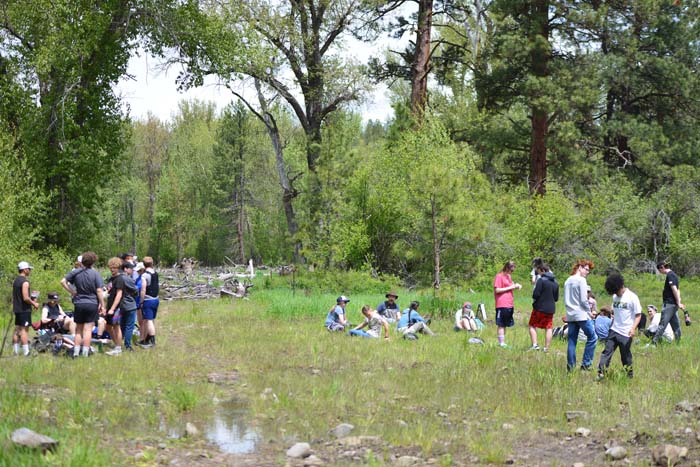Grande Ronde Community Science Project makes an impact on local students
Published 3:00 pm Wednesday, June 8, 2022

- Students break for lunch while attending the Qapqápnim Wéele / Grande Ronde community science project on Wednesday, June 1, 2022 at Bird Track Springs. Students participated in different monitoring projects while at the watershed.
LA GRANDE — Local high school students traded their science classroom and textbooks for the great outdoors and waders.
Thirty juniors from La Grande High School boarded buses Wednesday, June 1, for Bird Track Springs Campground, about 14 miles from La Grande, to participate in the Qapqápnim Wéele/Grande Ronde Community Science Project. The students, who were taking Brandon Galvez’s environmental science class, waded into the water for a hands-on learning experience.
“Kids deserve the opportunity to learn outside, and we’re in the perfect place for that,” said Carrie Lowe, community science coordinator contracted through the Grande Ronde Model Watershed.
Lowe said the program encourages students to pursue their scientific interests.
“I want kids to know that no matter what your gifts are, what your passions are, there is a place for you in science,” she said.
Throughout the spring a total of 330 students from Union and surrounding counties took part in the community science project, Lowe said. The project aims to build awareness about the importance of the watershed by engaging young people in monitoring projects.
Each group visited a different part of the Grande Ronde watershed — an area of land that channels rainfall and snowmelt to creeks, streams and rivers before eventually connecting to outflow points, like reservoirs, bays or an ocean — where they learned at three workstations: water quality, aquatic macroinvertebrates and riparian vegetation.
While working at the water quality station, students measured water temperature, pH level, channel width and stream flow.
At the aquatic macroinvertebrates station, they collected and sampled the types of invertebrates, such as insects or crayfish, in the water.
In the riparian vegetation zone, students learned about flora along the riverbank and helped catalog locations while learning which plants have cultural significance to Indigenous peoples. This workstation is done in partnership with the Confederated Tribes of the Umatilla Indian Reservation.
“We’re learning out in nature,” said Mason Miles, a high school student from La Grande. “We see it in the books, then get the hands-on experience.”
Outreach programs are beneficial for both students and schools. Field trips can be cost-prohibitive for schools, as they need to cover the price of buses and substitute teachers, Galvez said. Programs such as the Grande Ronde community science project get funding specifically to conduct outreach.
“This is a really nice partnership with the schools and program,” the LHS teacher said.
The Qapqápnim Wéele/Grande Ronde Community Science Project is funded entirely through grants and donations. This year it received $120,000 — from the Wildhorse Foundation, National Park Service’s Crayfish Study and Amazon Web Services in collaboration with the Greater Oregon Science, Technology, Engineering and Math Hub — to cover the cost of implementation, supplies, tribal guidance and local participation.
There is sometimes a debate within the scientific community whether to refer to projects like this as citizen science or community science, Lowe said.
“We use ‘community science,’” she said, “because we want the community to know that everyone is welcome.”
To learn more or get involved in the Qapqápnim Wéele/Grande Ronde community science project, email communityscience@grmw.org.





